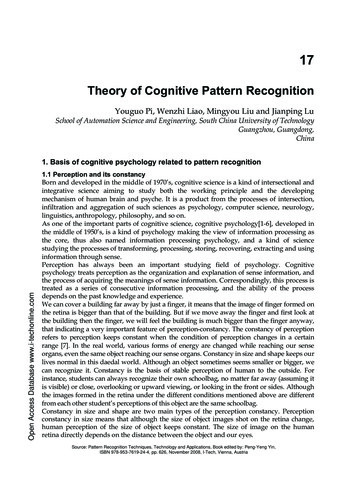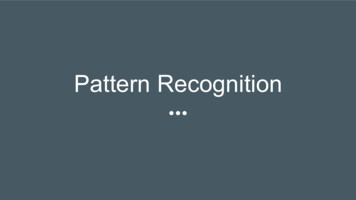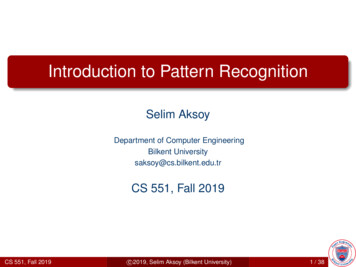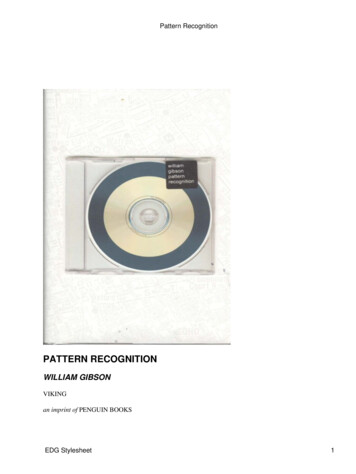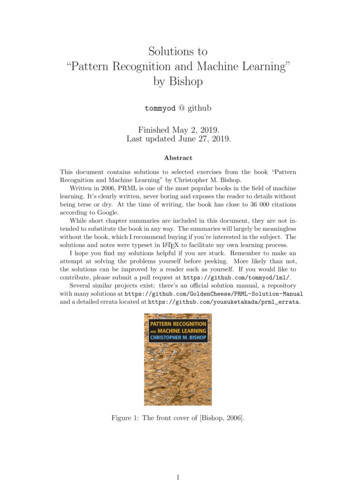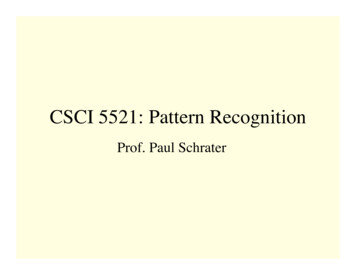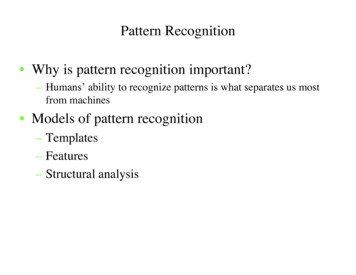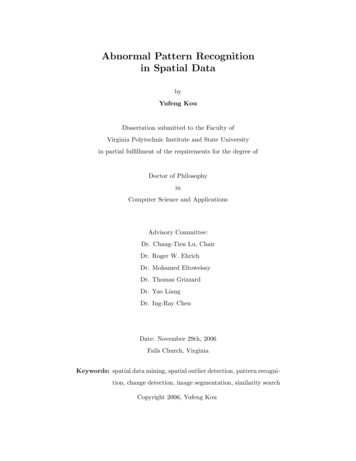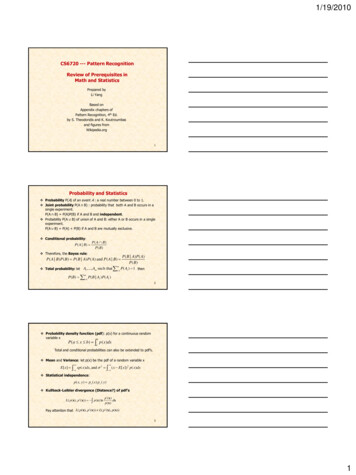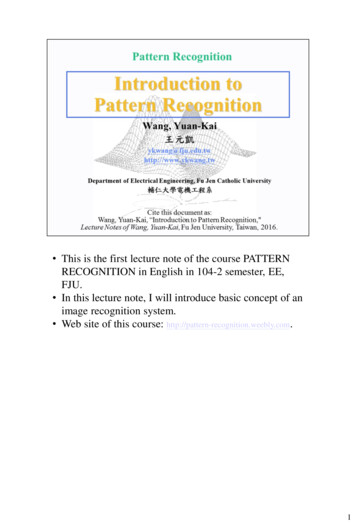
Transcription
This is the first lecture note of the course PATTERNRECOGNITION in English in 104-2 semester, EE,FJU. In this lecture note, I will introduce basic concept of animage recognition system. Web site of this course: http://pattern-recognition.weebly.com.1
2
3
4
A pattern recognition (PR) system is not identical to pattern recognition(PR) algorithms A PR system is more complete than a PR algorithm. A PR system needs to implement related techniques such as sensor,filtering and so on. But PR algorithms are just a key component of a PR system. PR systems and algorithms can be used to a lot of signals, such as speech,image, video, music, text, and so on. But this course will use only image signal as examples.5
Sensing is the first stage for a pattern recognition system. It is usually hardware, but not software. Terminologies about transducer Transduce: transform one energy form into another energy form Transducer: an instrument to transduce energy Ex.: microphone: a transducer to transform air vibration energy toelectron energy Ex.: camera: a transducer to transform photon energy into electronenergy Digital transducer: a transducer with the digitization of electronenergy Ex.: digital camera vs. analog camera: digital camera uses IC chipto digitize electron energy into digital signals(images), buttraditional (analog) camera uses film to get images. Terminologies about image sensing Image signals, image sensing, image sensor, camera Could you differentiate the difference among these terminologies? Sampling and quantization: AD (Analog to Digital) Conversion What is sampling: digitization in temporal domain What is quantization: digitization of intensity/quantity6
Why are noises generated? Dust, light, sampling, quantization, Why are objects unclear? Insufficient light(night), under exposure(wrong exposure setting ofcamera), de-focus (lens focus is not right), Both noise removal and object enhancement are done in next quisition7
Intrinsic noiseThe measured physical signal is already noisy, because the sensor willhave its own intrinsic noise level, from thermal and other noise sources.Even the raw un-quantized signal is accompanied by noise.Example noise intrinsic to the system The hiss on a cassette recording The rumble from a turntableSampling and quantization noisehttps://en.wikipedia.org/wiki/Quantization (signal processing)It is the noise generated by the analog to digital signal process (ADconversion). It includes two steps: sampling and quantization.Any physical measurement from sensors ( image sensors such asPhotoresistive target or vidicon-like, or solid-state arrays) are usuallyanalog quantities that must be quantized in order to become machinevariables.Sampling and quantization generates error(noise) Sampling and quantization produce approximate discrete data, There are errors between original continuous signal and discrete data.Sampling and quantization noise is produced by the approximation error The finer the quantization, the smaller is the noise The cost of equipment increases as some power of the fineness ofquantization - resolutionInterference noiseInterference effects cause slight variations of shape to occur betweenrepeat scans of the same objectEx. Electromagnetic agnetic interference8
Materials in Wikipedia to study noisesGaussian noise: https://en.wikipedia.org/wiki/Gaussian noisePoisson noise: https://en.wikipedia.org/wiki/Shot noise9
Preprocessing is the second stage for a pattern recognition system.The following slides will give some examples to explain these twogoals.10
Noise reduction is a process to reduce/remove noises in the imageIt is also called: noise removal, denoise, The noise in the left image of this slide is : salt-and-pepper noise (akind of impulse noise) Salt-and-pepper noise cannot be well-processed by Gaussian filter Salt-and-pepper noise can be well-processed by median filter. 11
What are the applications of these examples:Black regions on the planet: astronomy research to study the historyof the planet damaged by comet hits Face object: face recognition License plate: license plate recognition 12
License plate enhancement and recognition is a well-known andimportant application in ”intelligent video surveillance”. Two situations that make the object, license plate, looks bad Blur due to high-speed car driving or low-speed of camera shutter Strong light due to car head light13
You should learn preprocessing techniques in the “digital imageproessing” course. The course will teach histogram processing and linear filtering You can then learn nonlinear filter by yourself based on thefoundation of the course. This course is pattern recognition, so we will not teach preprocessingand image processing.14
Segmentation is the third stage of a pattern recognition system.Segmentation isolates the objects in the image into a new small image In order to carry out segmentation, it is necessary to detect certainfeatures that may not enter into the list of features utilized forrecognition. They are obtained from the direct (or preprocessed)measurements that are related to certain properties of preattentive vision.15
This figure comes from the textbook of digital image processingwritten by Gonzalez. In this example, The top image is a check of a commercial bank. The bottom image is a segmentation image with only signed nameand numbers, without the watermark of the check (i.e., thebackground of the image). This example uses a very simple segmentation technique:thresholding.16
This figure comes from the textbook of digital image processing writtenby Gonzalez. In this example (a) image is a blur image. The black circles in this image are to besegmented. (b) and (c) images are temporary processed results. (d) image is segmentation result. The white contours of all blackregions illustrate the segmentation results.17
To segment objects in complex images, we usually need to perform twosegmentation steps: first step to find rough place of the object, andsecond step to find the exact locations of objects This example is for license plate recognition, and we need to firstlysegment license plate, and then secondly segment the alphanumerics. Left top image is the original image captures at night. Right top image is a temporary processed image. Red rectangle in thisimage represents the first segmentation result that indicates the licenseplate. Bottom image show the final results of second segmentation. Sixalphanumeric in the license plate is isloated. These six characters canbe later recognized.18
Edge detection is a very useful for image/object segmentation. Edge image can be obtained by linear or nonlinear filtering.19
Color image segmentation is more difficult than grayscale imagesegmentation. We have to find texture, color and edge information in all three channels,and then use these information to segment the color image.20
Feature extraction is the fourth stage of a pattern recognition system.21
22
23
Two goals of feature extraction Compression: Reduction of dimensionality in pattern space There are too many measurements afteracquisition/preprocessing/segmentation. Many or most of them may not even help to distinguish theclass of the object from other classes. Feature extraction is the attempt to extract meaningfulfeatures from measurements. Perception: Rendering the features more suitable for the decisionprocess When we look at a printed page, scene, or anelectroencephalogram(EEG腦波圖), we don’t see an arrayof optical values. When we hear a speech, a siren, or an engine turning, wedon’t hear a time series of acoustic pressures. Our primary sensory systems do these. But we perceive letters, trees, -waves, spoken words,loud high-pitched sounds, and so on. Feature extraction of image objects is a complex technique. This course has not time to teach this technique. Please go for the course of Computer Vision.24
Classification is the fifth stage of a pattern recognition system. This is exactly the stage that will be explained in this course.25
How to do this by humans? Classify fish species by its size, length, width, lightness, How to do this by computers? Image preprocessing, feature extraction, and pattern recognition: apattern recognition system.26
Set up a camera on a platform that can places a fish Take a picture of the fish Write a program to Segment the fish: Isolate fishes from backgrounds. It includes denoising,enhance the image by filtering, and segmentation. This is not the topic of this class. But it will be taught by the class”Digital Image Processing” Extract features of fish: Length, lightness, width, number and shape of fins,position of the mouth, etc This is not the topic of this class. But it is taught by the class ”ComputerVision” Classify the species of the fish: Use pattern recognition algorithms to dothis. This is the topic of this course Let us suppose that we can write a program to successfully Segment the fish object in an image. Extract the features of the fish, such as length, width, lightness, and so on. So next slide we go further to the ”classification”step.27
Horizontal axis is the length of fishes.Vertical axis is the number of fishes with respect to fish length.Black line shows the histogram of salmon. Red line shows thehistogram of sea bass.For example, the number of salmon with length 5 is 16. The numberof sea bass with length 20 is 22.Black dotted line represents ”threshold” to classify salson and sea bass.If we set the threshold to be 11.1, as shown in this figure.Then all fishes with length less than 11.1 is classified to be salmon.All fishes with length larger than 11.1 is classified to be sea bass.So, some sea bass fishes with length less than 11.1 is mis-classified,and so are sea bass fishes with length larger than 11.1Mis-classified fishes are called classification error. With these errors wecan then calculate error rate or accuracy of this classification withrespect to this threshold: 11.1.Each threshold has an error rate.Some thresholds have higher error rates, and they are not goodthresholds.The best threshold is the threshold with minimum error rate. ButTwo questionsWhat is the best threshold in the example?If the error rate of the best threshold is not good enough, can we getbetter classification by other ways?28
The length feature in previous slide is a bad feature. Let us change the feature to be lightness of fishes. The graph seems to be better than the graph of length, because the twohistograms of two fish species are not ”seriously overlapped”. What is the best threshold in this example? Suggestion: move the threshold (decision boundary) toward smallervalues of lightness in order to minimize the cost (reduce the number ofsea bass that are classified salmon!) Question Can we get more better accuracy than using the lightness feature?29
30
Now both axes represent features for classification.Important concepts shown in this illustrated figureDecision boundary (also called threshold in 1D example)Noise (some salmons locate in the region of sea bass, and vice versa)Currently we use straight line to be decision boundaryWe can move the line and change its direction(slope)Lines at different location and with different slope have differenterror rate.We have to find he best line (decision boundary) that has theminimum error rate.Classifier and discriminantThe decision boundary (straight line) is also called classifier and/ordiscriminant.DiscussionsCould we add more features than two?We might add other features that are not correlated with the ones wealready have. A precaution should be taken not to reduce theperformance by adding such “noisy features”QuestionsHow to find the discriminant/classifier/decision boundary? Machine learning and pattern recognitionCould we use non-straight line or curve to be decision boundary?31
Ideally, the best decision boundary should be the one which provides anoptimal performance such as in this figure. In this figure the decision boundary is a high-order curve, but not astraight line. This curve looks like a very good classifier, because it has zero error. However, it is not a good classifier because of the issue of generalization Its accuracy for current fishes is 100%. Will it be still good for new unknown fishes? No, absolutely not. Practically, this classifier is too specialized for current fishes, thus ithas no generalization for future unknown fishes.32
In reality, this may be the best classifier. This classifier(decision boundary) is a second-order curve. For current fishes Its accuracy is better than straight lines, but is lower than the highorder curve in previous slide. For new unknown fishes Its accuracy should be better than those accuracies of straight lines andhigh-order curve.33
How can a computer program “automatically” find the best classifier? We need two things Training algorithm Training data What is training algorithm Training algorithm uses training data to find the best classifier. Buthow? Remember that each classifier has an error rate. And the best classifierhas the minimum error rate. We have infinite number of classifiers: infinite straight lines andinfinite curves. Each classifier has an error rate. We can find the best classifier only if we calculate all of the error ratesof classifiers and find the minimum of these error rate values. But it is a mission impossible. Therefore a lot of complex algorithm are developed to conquer thisdifficulty. Next slide shows some popular training algorithms.34
In this course, we will focus more on neural networks and deep neuralnetworks.35
In most real PR system, it is not possible to achieve 100% correctrecognition. For example: OCR, Fingerprint Recognition All we want is to achieve “the lowest possible” error rate.36
37
38
A pattern recognition (PR) system is not identical to pattern recognition (PR) algorithms A PR system is more complete than a PR algorithm. A PR system needs to implement related t
